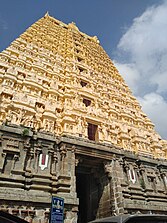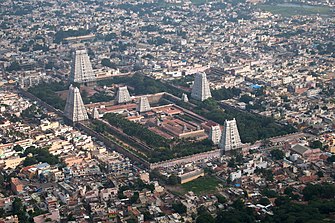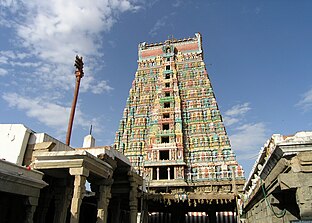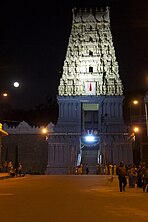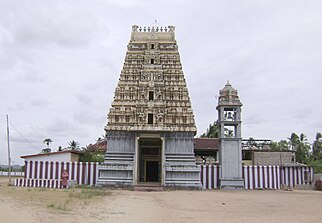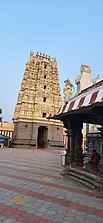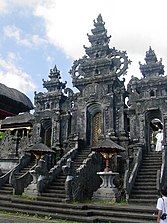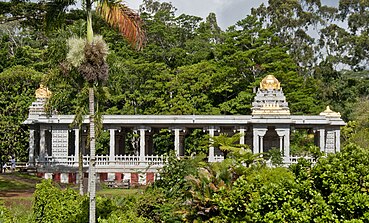Gopuram
Agopuramorgopura(Tamil:கோபுரம்,Telugu:గోపురం,Kannada:ಗೋಪುರ) is a monumental entrance tower, usually ornate, at theentranceof aHindu temple,in theSouth Indian architectureof thesouthern Indianstates ofTamil Nadu,Andhra Pradesh,Kerala,Karnataka,andTelangana,[1]andSri Lanka.In other areas of India they are much more modest, while in Southern Indian temples they are very often by far the highest part of the temple.
Ancient and early medieval temples feature smallergopuram,while in later temples they are a prominent feature ofHinduDravidian style;[2]in many cases the temple compound was expanded and new larger gopuram built along the new boundary. They are topped by thekalasam,a bulbous stonefinial.They function as gateways through the walls that surround the temple complex.[3]Another towering structure located towards the center of the temple is theVimanam.Both of them are designed and constructed as per rules given in the texts ofVaastu shastra.[4]
The gopuram's origins can be traced back to early structures of thePallavakings, and relate to the centralshikharatowers of North India. Between the twelfth and sixteenth century, during thePandya,NayakaandVijayanagaraera when Hindu temples increasingly became a hub of the urban life, these gateways became a dominant feature of a temple's outer appearance, eventually overshadowing the inner sanctuary which became obscured from view by the gopuram's colossal size and courtyards.[5]It also dominated the inner sanctum in amount of ornamentation. Often a shrine has more than one gopuram.[1]They also appear in architecture outside India, especiallyKhmer architecture,as atAngkor Wat.
A large Dravidian-style temple, or koil, may have multiple gopurams as the openings into successively smaller walled enclosures around the main shrine, with the largest generally at the outer edges. The temple compound is typically square or rectangular with at least the outermost wall having gopuras, often from the four cardinal directions. The multiple storeys of a gopuram typically repeat the lower level features on a rhythmic diminishing scale.[5]The inner sanctum and its towering roof (the central deity's shrine) is also called theVimanam,although in the south it is typically smaller than the gopurams in large temples.
Etymology[edit]
TheTamilderivation is from the two words: கோ (kō) and புறம் (puram) meaning 'king' and 'exterior' respectively.[6]It originates from theSangam agewhen it was known as ஓங்கு நிலை வாயில் (ōnggu nilai vāyil) meaning 'imperishable gateway'.[7]
TheTeluguderivation is from the two words: కోపు (Kōpu) and అరం (Araṁ) meaning "Top" and "to exist".[8]
An alternative derivation is from theSanskritwordgopuram,which can be broken down togo(Sanskrit:गो), which means either 'a city' or 'a cow', andpuram(Sanskrit:पुरम्), 'a town', or 'a settlement'.[9]
Dr. Sthapati explains the meaning of the words gopuram and vimanam thus. Vimanam means measure, indicating the number of measures made in the construction and design of that structure. Gopuram consist of two words, gawa and puram, meaning the place from which all the energy that exists in all living beings comes inside.[10]
Architecture[edit]

A gopuram is usually a taperingoblongin form with ground-level wooden doors, often richly decorated, providing access. Above is the tapering or"battered"gopuram, divided into many storeys (talas), which diminish in size as the gopuram tower narrows. Usually the tower is topped with abarrel vaultedroof with a finial.[5]The form began rather modestly in the 10th century, as atShore Temple,Mamallapuram,with the 11th centuryBrihadeeswarar TempleinThanjavurmarking a crucial step forward with two multi-storey gopurams from that period, much larger than any earlier ones, though much smaller than the main tower (vimanam) of the temple. The four gopurams of theThillai Nataraja Temple, Chidambaramare important early examples, begun in the mid-13th century but completed over a longer period.[11]Gopurams are exquisitely decorated with sculpture and carvings and painted with a variety of themes derived from theHindu mythology,particularly those associated with the presidingdeityof the temple where the gopuram is located.[citation needed]
The two tallest gopuras are both modern, at least in part. TheRanganathaswamy Temple, Srirangam,Tamil Nadu,has 21gopurams(tower gateways), including the towering 239.5-foot (73.0 m)Rajagopuram(shrine of the main gateway), which is claimed as the tallest temple tower in Asia. The 73-metre (240 ft)-tall 13-tieredRajagopuramwas completed in 1987 and dominates the landscape for kilometers around, while the remaining 20 gopurams were built between the 14th and 17th centuries.[12]Competing for the title of "tallest" is the twenty storey 249-foot (76 m) gopura at the modernMurdeshwarTemple, which, unusually, is provided with alift.[13]
-
Ayothiapattinam,Ramaswamy temple
-
On left is a gopuram, to the right above the sanctum isvimana
See also[edit]
- List of tallest Gopurams
- Candi bentar,split gateways for Indonesian Hindu temples
- Paduraksa,greater gateways to inner and more sacred areas in Indonesian Hindu temples
Notes[edit]
- ^ab"gopura".Encyclopædia Britannica.Retrieved20 January2008.
- ^Ching, Francis D.K.; et al. (2007).A Global History of Architecture.New York: John Wiley and Sons. p.762.ISBN978-0-471-26892-5.
- ^Ching, Francis D.K. (1995).A Visual Dictionary of Architecture.New York: John Wiley and Sons. p. 253.ISBN0-471-28451-3.
- ^Ananth, Sashikala (1 January 2000).Penguin Guide to Vaastu: The Classical Indian Science of Architecture and Design(2 ed.). Mumbai: Penguin.ISBN014027863X.
- ^abcMichell, George (1988).The Hindu Temple.Chicago: University of Chicago Press. pp. 151–153.ISBN0-226-53230-5.
- ^Sellby, Martha A.; Indira Viswanathan Peterson (2008).Tamil geographies: cultural constructions of space and place in South India.SUNY Press.
- ^S. Sundararajan (1991).Ancient Tamil country: its social and economic structure.Navrang.
- ^Vaachaspathy (9 November 2020).Bangaru Nanelu.
- ^Lienhard S.,von Hinèuber O.(2007).Kleine Schriften: Supplement(in French). Harrassowitz Verlag. p. 414.ISBN9783447056199.
- ^Sthapati, Dr. V."Lecture at Brihadeeshwara temple (part 2)".You tube.
- ^Harle, 320-325
- ^"Towers" on temple websiteArchived21 December 2022 at theWayback Machine;Tamilwebworld
- ^"Murudeshwar Temple Now Tallest Gopuram in Asia", April 2008
References[edit]
- Dallapiccola, Anna L. (2002).Dictionary of Hindu Lore and Legend.London: Thames & Hudson.ISBN0-500-51088-1.
- Harle, J.C.,The Art and Architecture of the Indian Subcontinent,2nd edn. 1994, Yale University Press Pelican History of Art,ISBN0300062176



